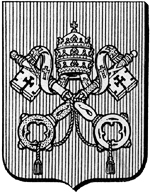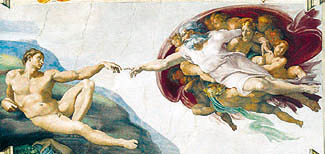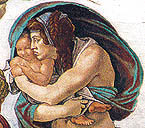Vatican Museums

The three things you MUST see in the Vatican Museums are:
The Sistine Chapel,
the Raphael Rooms (gigantic frescoes in four large rooms), and
the Laocoön, sculpture in the Belvedere Octagonal courtyard. To be visited in the opposite order - but as you swish down the long Galleries on your way to the Sistine Chapel, don't miss the fabulous tapestries and the frescoes of city maps particularly Venice.
Sistine Chapel

(Cappella Sistina). The Sistine Chapel is at the end of the vast complex of galleries called, in the plural, Vatican Museums.
The sole entrance to the Museums, on Viale del Vaticano, is a 15 minutes walk around the Vatican wall from St. Peter's, or take a shuttle bus departing from (and returning to) the orange sign on the left side of St. Peter's Square (see: Vital Data).
St. Peter's Basilica is among the few churches that do not close at noon; it remains open until 6pm in summer and 7pm in winter, so it is advisable to visit the Museums first, then return to the church.
In fact, your last stop in the Museums is likely to be the Sistine Chapel, from which stairs descend directly to the entrance to St. Peter's.
As soon as you go into the entrance of the Museums, take an elevator up. You will have to select one of the color-coded itineraries since you cannot hope to see everything. As your Musts include the Sistine Chapel and the Raphael Rooms, which are half an hour's walk from the entrance, save your energy for them. In any case give yourself a couple of hours for this tour, and there is plenty to keep you enthralled for a long morning. Two or three days would permit you to survey all 4-1/2 miles of galleries.
The masterpieces of Michelangelo (1475-1564) on the ceiling and the altar wall have recently been returned to their original vibrant colors.
 Five centuries of mildew and candle black were swabbed away, square-inch-by-square-inch, by a team of world-class art restorers using non-intrusive materials such as distilled water and Q-tips.
Five centuries of mildew and candle black were swabbed away, square-inch-by-square-inch, by a team of world-class art restorers using non-intrusive materials such as distilled water and Q-tips.
The colors may look too electric to you, but Michelangelo ground up his own coloring pigments and wanted his fresco to look as bright as you see it today.
The 9 main panels on the ceiling represent the 5 major events in the Book of Genesis plus “The Fall of Man”, “Noah's Sacrifice”, “The Flood" and "Noah's Drunkenness”. Don't miss “The Creation of Adam”, a youthful naked figure languidly reaching out his finger toward an elderly all-powerful God - a paradigm of young Michelangelo's relationship with the older, dominating Pope.
Along with the “Mona Lisa” (at the Louvre in Paris) by his contemporary Leonardo da Vinci (1452-1519), this is considered the world's greatest visual masterpiece.
Michelangelo was young and optimistic when he painted this glorious ceiling. He was breaking new ground in both fresco style and iconography; his love-hate relationship with the bullying Pope was an inspiration for his enthusiasm.
As you can see in the dark and frightening “Last Judgment”, done a quarter of a century later, history had changed the Catholic Church, the person of the Pope and the attitude of the painter. By denouncing the sale of Papal indulgences, Martin Luther had precipitated the Protestant schism and the Reformation; also the Holy Roman Emperor's armies had imprisoned the Pope and perpetrated the 1527 Sack of Rome.
For a Renaissance artist like Michelangelo, a tireless thinker and writer, Rome's Sack was God's punishment for the sinfulness of man on Earth. He mirrored that pessimism in this surprising scene in which an implacably judgmental Christ summons the dead from their tombs and assigns them to either heaven or an eternally horrible hell.
| Sistine Chapel History 1477-80. Pope Sixtus IV della Rovere had this chapel built with the exact dimensions attributed to Solomon's Temple in the Bible. Converting the Vatican from a Medieval to a Renaissance Palace, he commissioned the great artists of the day including Botticelli, Perugino and Ghirlandaio to fresco the sidewalls, Raphael later created tapestries that are sometimes hung at the base of these walls. 1508-12. Pope Julius II della Rovere, Sixtus' nephew and one of the gutsy giants of the era (he waged war in full armor to win back papal domains other Popes had lost) used military threats against Florence to overcome Michelangelo's unwillingness to come to Rome and paint the Sistine Ceiling. It took only four years for Michelangelo, mostly lying on his back and working alone, to cover the 800 square meters ceiling with 300 gigantic brightly-colored figures. 1534-41. Twenty-two years later, a Florentine Pope, Clement VII Medici, persuaded Michelangelo to fresco the end wall with “The Last Judgment”, to that the aging master devoted six years. It shows 250 figures, most of which were originally nude; the panties were added later by prudish popes. Nowadays it is the site of Papal elections, during which the voting cardinals (those under 80) are strictly confined to these quarters, with bed and board in adjacent rooms. The cardinals sit along the walls on canopied thrones while two votes are held every day, until a two-thirds vote leads to the senior Cardinal's famous cry "Habemus Papam" (We have a Pope!). The ballots are burned after each round, with the addition of wet straw to produce black smoke if the vote is inconclusive and dry straw for white smoke to announce the successful election to the crowds anxiously waiting outside. |